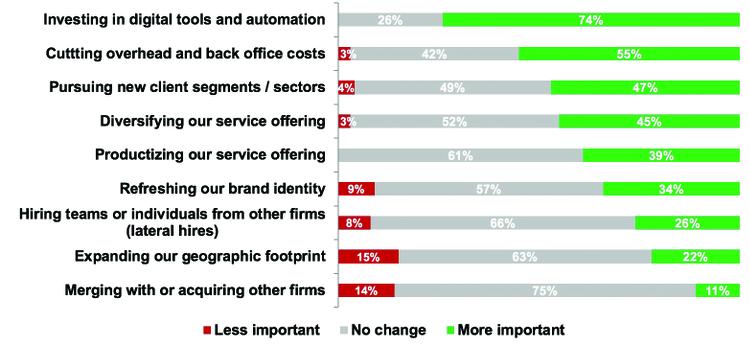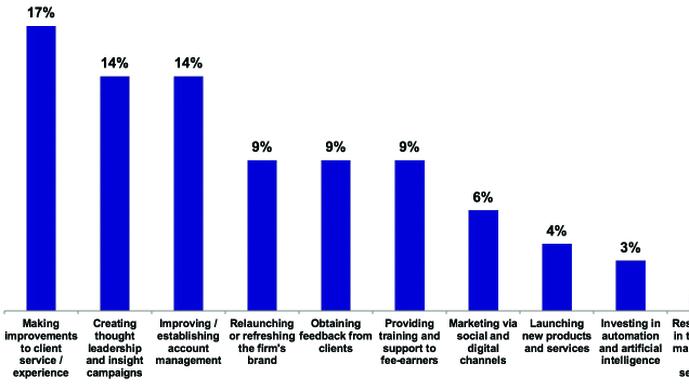Is it time for a radical marketing rethink?
Now in its ninth cycle, our annual benchmark survey shows a lot can change in a year. Alastair Beddow considers whether there are reasons to be optimistic about 2021.
What a difference 12 months can make. Analysing the results from the previous iteration of our benchmark survey, I commented that 2020 marked a moment for professional services marketers and BD professionals to tackle new and exciting priorities for the decade ahead. Sadly, dealing with the fallout of a global pandemic didn’t feature on anybody’s to-do list.
After a turbulent and testing year, professional firms and their clients have quickly learned to adapt to a new operating environment. However, most marketing leaders remain cautious about the year ahead. When asked about how confident they feel about 2021, 63% said they felt only ‘somewhat confident’: they are concerned about further change and disruption, but they believe they can withstand this.
If the last 12 months have proved anything, it is that marketing leaders and their teams are agile, resilient and creative. They will be required to utilise these skills yet again this year as they navigate continued disruption and uncertainty. Just over a third (37%) of our survey respondents said that at this moment in time, they find it difficult to plan more than three months in advance.
Strategic focus: routes through the crisis
Although long-term planning remains challenging, our benchmark provides evidence that professional firms are making clear strategic choices about their future. When asked what has become more important for their firm since the emergence of COVID-19, a cluster of three priorities emerge (see figure 1 below).

First, investment in digital tools and automation. 74% say this has become more important. Over the last 12 months, firms invested in systems to enable effective remote working and to maintain service provision. Over the months ahead, firms will accelerate their technology investment to find efficiencies through automation and embrace more sophisticated data analytics to give them the edge over competitors. This will apply to both client-facing delivery and marketing and business development systems.
Second, cost management will remain front of mind. While investment in technology is likely to be ringfenced – 55% in our survey, for example, say their spending on business development technology and systems will increase – marketing leaders will be expected to find savings elsewhere. The M&BD budget is not immune from firm-wide cost reduction pressures.
Third, diversification will drive recovery. Just under half (47%) of firms say they will pursue growth opportunities by expanding into new client segments. A similar proportion (45%) will broaden their service propositions, while 39% will look at business model change, embracing productisation of their core service propositions.
Clarifying your proposition
Whichever strategies that firms take to succeed throughout 2021, the marketing leaders in our research believe they and their teams have an important role to play to ensure their firm remains focused on the elements that drive competitive advantage.
As one Business Development Director at a leading law firm explains, delivering consistently excellent client experiences will be even more important for firms to remain one step ahead of their peers:
“Although we offer broadly similar services to many other law firms, except for some particular specialisms, our competitive advantage will come from delivering our services in the way that our clients want them.”
Marketing team priorities: Engaging clients in new ways
The strategic priorities identified in our survey translate into a clear set of planned activities. As Figure 2 shows, making improvements to client experience has regained the top position this year on the priority list after being overtaken by relaunching or refreshing the firm’s brand in our 2020 benchmark research.

Emerging strongly this year is a recognition that, although client experience has been a leading priority for firms for many years, how this is activated in a virtual environment will be different. Now is a moment for marketing leaders to pause and reflect on their approaches. Over two-thirds of those surveyed (69%) agree that 2021 offers an opportunity to radically rethink the way the firm does M&BD.
One of the most immediate areas for reinvention will be the need to find new ways to engage clients to offset the continued lack of in-person M&BD events expected throughout 2021.
When asked about which approaches were most effective, 84% placed regular virtual key account meetings with clients among their top three activities for maintaining engagement. This was followed closely by 80% who selected thought leadership and content marketing. Interestingly, this is some way ahead of the 55% who thought virtual conference and webinars were an effective strategy to replace in-person marketing.
Demonstrating value
Regardless of how they innovate their M&BD this year, functional leaders say they will be under greater pressure to demonstrate the return on investment (ROI) of their spend. 55% of those surveyed agree that the pressure to demonstrate ROI will be greater than ever before.
Among the metrics and measurements used to demonstrate value, marketers plan to align reporting of their impact more directly with financial metrics this year. The most deployed indicator of marketing success is contribution to revenue growth, closely followed by new clients won and pipeline conversion.
Marketing budget and headcount: a tale of two halves
After successive rises over the last eight years in our benchmark, this year marks the first time that marketing budgets are on a downward trajectory. Figure 3 shows that the average budget will decrease by 1.3%, compared with a rise of 2.3% last year.

On face value, this suggests a modest cut in challenging circumstances. However, this figure doesn’t tell the whole story. Looking behind the headline numbers, we find that just under half (46%) of participants in our benchmark anticipate a marketing budget cut over the next 12 months. Among this group, the average budget cut is significantly higher at 24.4%.
On a more positive note, 48% anticipate their budget will increase this year. Among this segment, the average increase is 20.7%. For many, this will be restoring budget that was frozen or removed last year. However, it does signal that firms are willing to invest in M&BD to accelerate their recovery from this crisis.
A similar picture emerges when we asked about marketing team headcount. Nearly a third of firms (31%) reported reducing the size of their teams in 2020. Those who cut staff lost, on average, a quarter (24%) of their workforce. This year, headcount is expected to rebound, with an average growth of 8.3% in team size, suggesting that firms are looking to replace skills and capacity lost during the previous year.
Reasons to be positive
There are many scenarios possible for 2021, ranging from a rapid rebound following a successful mass immunisation programme to continued disruption and deep recession. The marketing leaders and firms that will be most successful over the year ahead, will have planned for different scenarios and will adapt their approaches in real time.
Whatever 2021 holds, there are many reasons to be positive. The respondents to our benchmark tell that in 2020, with crisis also came opportunity. They were able to implement change at a quicker pace than ever before. Firm-wide leaders woke up to the importance of client experience and successful external communications. Teams and individuals let their creativity and resilience shine through.
The last word goes to one Marketing Director who summarises what is hopefully the most enduring experience of the last year for us all:
“As a team we know each other better. Zoom has given us a window into our lives outside of the office and the personal chaos that we all manage on a daily basis. As a result, I think we’re kinder, more understanding and supportive than ever before.”
Alastair Beddow is Managing Director at Meridian West, and a co-author of Professional Services Leadership Handbook.

